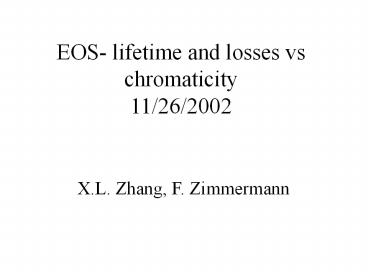X.L. Zhang, F. Zimmermann
1 / 6
Title:
X.L. Zhang, F. Zimmermann
Description:
... instability and beam loss quenched the Tevatron. some related informations: ... but a quench occurred at DCv = -21. in p-bar removal study on November 17, proton ... –
Number of Views:21
Avg rating:3.0/5.0
Title: X.L. Zhang, F. Zimmermann
1
EOS- lifetime and losses vs chromaticity11/26/200
2
X.L. Zhang, F. Zimmermann
2
end-of-store study on 11/26 reduce CH,V by 10
units in steps of -1
no effect on intensity or loss, some increase in
H Schottky power at 10 sudden instability and
beam loss quenched the Tevatron
3
- some related informations
- quench appeared to have been caused by p-bars
- (signature of pbar quench at F48, by Dean et
al.) - on November 4 Xiaolong had scanned both Ch and
Cv - (independently) by 24 and 20 units without
problems - but a quench occurred at DCv -21
- in p-bar removal study on November 17, proton
- chromaticities were measured as Ch13, Cv16
- (i.e., lower in H)
- according to Tanajis calculation the
0-amplitude - chromaticities of p-bars are lower by 10 and
1 units - compared with protons (at 3s the differences
are 6 and - -3)
if we trust these numbers the nominal pbar
chromat. is Ch3 only, which was dropped to 7
in the course of the study - no wonder the beam
became unstable!
4
absolute changes were certainly larger on
November 4, but
5
perhaps we cannot deduce from the two successful
pink curves that the brown one should be stable
6
circumstantial observation that the sextupole
feeddowns (S5F1A-S5D3A) were 50 different on
the two occasions, namely Nov 4 4.2
- 4.3 Nov 17/26 6.7
why were they different, and does this matter
for the p-bar stability?































